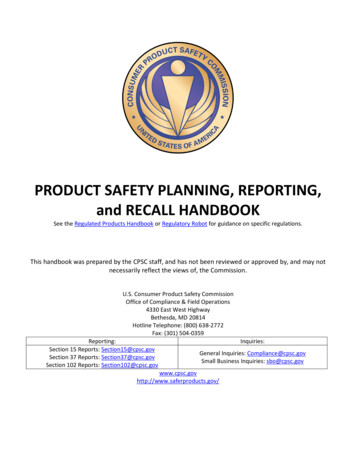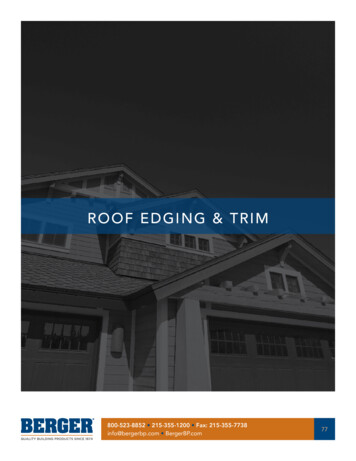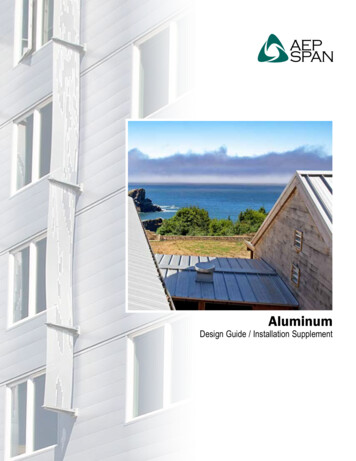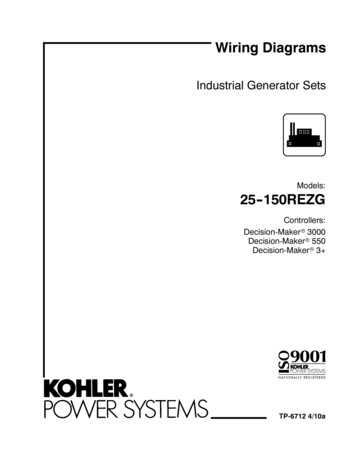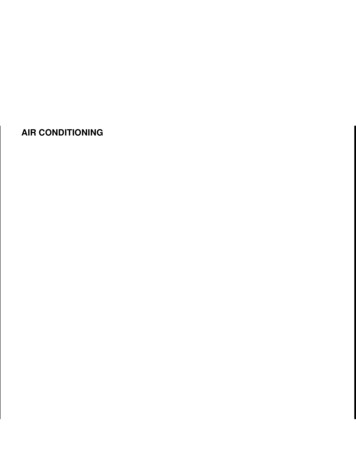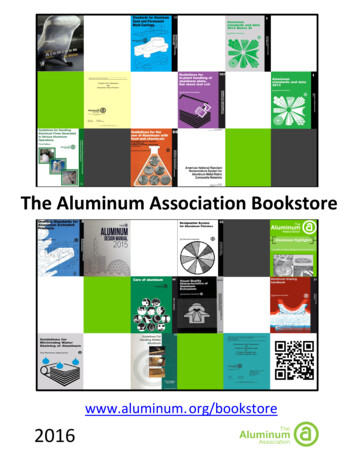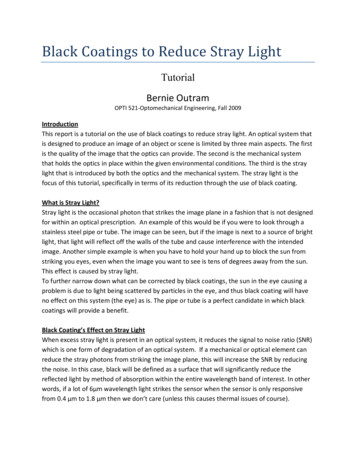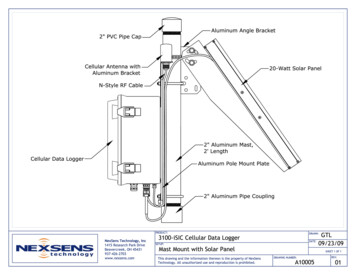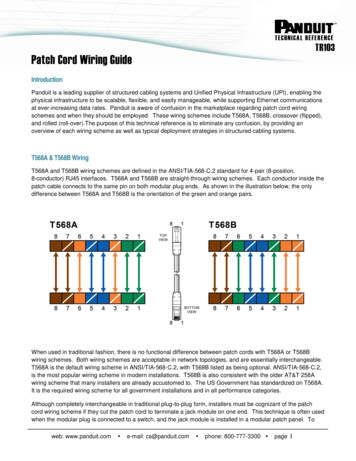
Transcription
REPAIRINGALUMINUM WIRINGU.S. Consumer Product Safety CommissionBethesda, MDwww.cpsc.govwww.SaferProducts.govPublication 516
ALUMINUM WIRINGThe U.S. Consumer Product Safety Commission (CPSC) staff and other government officials have investigated numerous hazardous incidents and fires throughout the nation involving aluminum branch circuit wiring. A national survey conducted by Franklin Research Institute for CPSC showed that homes built before 1972, and wired with aluminum, are 55 times more likely to have one or more wire connections at outlets reach“Fire Hazard Conditions”1 than homes wired with copper. That survey encompassed onlythe wire connections at outlets. It did not address other types of aluminum wire connections and splices in homes that are also prone to fail. No information was developed foraluminum-wired homes built after 1972.The fire hazard investigated by CPSC occurs at connections with aluminum wire, includingreceptacles or switches and junction boxes; or the hazards occur with major appliances,including dishwashers or furnaces, for example. There are several deterioration processes inaluminum wire connections that cause increased resistance to the flow of electric current,resulting in damage that is cumulative in effect. That increased resistance causes overheating, sometimes at hazardous levels, when current is flowing in the circuit.A shortage of copper in the mid 1960s caused builders to increase the use of aluminumwire in residential electrical distribution systems from the few large-power circuits (i.e., forelectric clothes dryers and ranges), to general purpose 15- and 20-ampere-rated circuits.Homes built before 1965 are unlikely to have aluminum branch circuit wiring. Electricalcables installed between 1965 and the mid 1970s in new homes, in additions, and as partof rewired/new circuits may contain aluminum wiring. On April 28, 1974, two people diedin a home in Hampton Bays, N.Y. Fire officials determined that the fire was caused by anoverheating aluminum wire connection at a wall receptacle.The survey conducted by the Franklin Research Institute defined “Fire Hazard Conditions” to occur when receptaclecover plate mounting screws reached 149 C (300 F), or sparks were emitted from the receptacle, or materials around the receptacle were charred.1 1Publication516 June 2011
TROUBLE SIGNSUnfortunately, failing aluminum-wiredconnections seldom provide easily detectedwarning signs. Aluminum-wired connections and splices have been reported to failand overheat without any prior indicationsor problems.If you notice any signs of a problem, havea qualified electrician determine the cause.DO NOT TRY TO DO IT YOURSELF.You could be electrocuted, or you couldmake the problem worse. Signs of electrical system problems include hot-to-thetouch face plates on receptacles or switches;flickering lights; circuits that don’t work;or the smell of burning plastic at outlets orswitches.IDENTIFYING ALUMINUM WIRINGVirtually all of the aluminum wiring wasinstalled as plastic-sheathed cable (typeNM, often called “Romex”) with no readily discernable distinction from a cable withcopper conductors. Look at the printedor embossed markings on the outer jacketof the electric cables, which are visible inunfinished basements, attics, or garages.If necessary, use a flashlight shining onthe surface at a low angle to help makethe e mbossed markings readable. Cablewith aluminum conductors will have “Al”or “Aluminum” and other informationmarked on one side of the cable jacketevery few feet along its length. (Note: besure to read as much of the marking aspossible because the marking “CU-clad”or “ Copper-clad,” in addition to the “Al”or “ Aluminum,” means that the cable usescopper-coated aluminum wire and is notcovered by the repair recommendationsoutlined in this publication).2,3If you are unable to identify the type ofwire in your home by this method, butyou suspect that you have aluminumwire, have a qualified electrician make the determination.If your home has aluminum wiring that hasnot been remediated, CPSC recommendsa permanent repair of the connections, asdescribed in the following sections.FIXING THE PROBLEMAluminum wiring can be replaced orrepaired to effectively and permanently reduce the possibility of fire and injury due tofailing (overheating) wire connections andsplices. It is highly recommended that youhire a qualified electrician to perform thisremediation.Other than complete replacement of aluminum wire with copper wire, there may2 Aluminum and copper-clad aluminum cables are sized at No.10 and No.12 AWG for 20-ampere and 15-ampere rated c ircuits,r espectively, as opposed to No.12 and No.14 AWG for copper conductors.3 The repairs outlined in this publication do not apply to larger gauge aluminum wire circuits and connections used fors ervice entrance cables, electric clothes dryers, and cooking ranges.2
be numerous potential solutions for thepermanent repair of hazardous aluminumwire connections and splices. However,CPSC can recommend repair methods orproducts only where there is satisfactory,documented evidence that the methods orproducts meet the following criteria: Safe. The method or product must besafe and not increase the risk of fire orother hazards. E ffective. The method or product mustbe effective and successfully eliminate orsubstantially mitigate the fire hazard. P ermanent. The method or productmust affect a permanent repair. Methodsor products designed to address temporary or emergency repair situations, butwhich may fail over time, are not considered permanent.1) Complete Replacement with CopperCableReplacement of the aluminum branch circuit conductors with copper wire eliminatesthe primary cause of the potential hazards,the aluminum wire itself. Depending onthe architectural style of your home andthe number and locations of unfinishedspaces (e.g., basements and attics), it maybe relatively easy for a qualified electricianto rewire your home. A new copper wirebranch circuit system would be installed,and the existing aluminum wire could beabandoned inside the walls. This is the bestmethod available; but for many homes,rewiring with copper is impractical and/orprohibitively expensive.Based on these standards, as of the dateof this publication, CPSC approves of onlythree methods for a permanent repair.41) Complete Replacement of CopperCable2) COPALUM Method of Repair3) Acceptable Alternative RepairMethod/ AlumiConn Connector4 Any individual or company that develops a method or product that meets these CPSC standards for a safe, effective,and p ermanent repair of aluminum wire connections and splices and desires that the CPSC consider recommending themethod or product may submit documentation of compliance with such standards to: CPSC, 4330 East West Highway,Bethesda, MD 20814. Recommendation of products or methods is rare and is solely within the discretion of the CPSC. Theburden and costs of establishing compliance with such standards is the responsibility of the requestor. Consideration of aproduct or method is not intended and does not create any right or benefit, substantive or procedural, enforceable at lawor in equity, by any party against the U.S. Consumer Product Safety Commission or the United States, its officers, employees, or agents, or any other person.3
2) COPALUM Method of RepairAs an alternate to rewiring with copper,CPSC recommends attaching a shortsection of copper wire to the ends of thealuminum wire at connection points (atechnique commonly referred to as “pigtailing”), using a special connector namedCOPALUM to join the wires. CPSC staffconsiders pigtailing with a COPALUM connector to be a safe and permanent repair ofthe existing aluminum wiring. The repairshould include every connection or spliceinvolving aluminum wire in the home, including outlets, dimmers, switches, fixtures,appliances, and junction boxes. The repaired system, with short copper wire extensions at every termination throughout thehome, permits the use of standard wiringdevices, including receptacles and switches.The COPALUM repair method is recommended by CPSC on the basis of CPSCsponsored research, laboratory tests, anddemonstration projects. This repair methodhas been thoroughly proven by more thana quarter of a century of field experience toprovide a permanent, low-resistance electrical connection to aluminum wire. TheCOPALUM repair method eliminates thealuminum connection failure problems andstill uses the existing, installed aluminumwire. The COPALUM repair method hasbeen shown to be practical for installationin an occupied and furnished home.4Every connection of aluminum-to-aluminum or aluminum-to-copper wire should berepaired in order to obtain the maximumbenefit from such repair work. All appliances connected directly to No.12 or No.10AWG aluminum branch circuit wiring (e.g.,dishwashers, cooling equipment, heaters,air conditioners, and light fixtures) must berepaired in addition to wall outlets, switches, junction boxes, and panel boxes.The COPALUM connector is a speciallydesigned system that includes a metal sleeveintended to be installed only with a dedicated power tool and crimping die to makea permanent connection, that is, in effect,a cold weld (the precision dies in the COPALUM tool compress the connector andwires using upwards of 10,000 pounds offorce, as required to make the permanentaluminum wire connection).
The tool is shown in the illustration below.An insulating sleeve is placed around thecrimp connector to complete the repair.The copper wire pigtail is then connectedto the switch, receptacle, or other termination device. An example of a repaired receptacle outlet is also illustrated below.Only electricians who are trained by themanufacturer to use the tool properly areauthorized to install COPALUM connectors. CPSC staff e mphasizes that thistraining is necessary to ensure that theelectrician uses the careful, professionalworkmanship and thoroughness required tomake the crimp connector repair safe andpermanent.COPALUM Crimp Connector and its Specialized I nstallation ToolingRecommended COPALUM Connector Repair5
To determine if there is a COPALUM installer in your region, visit: home.asp, or contact the manufacturer at(800) 722-1111 or at the following address:TE ConnectivityAttn: COPALUM Aluminum Wire RepairProgramP.O. Box 3608Harrisburg, Pa. 171053) Acceptable Alternative Repair MethodCPSC staff recognizes that copper replacement may be cost prohibitive and that theCOPALUM repair may be unavailable ina locality. Based upon an evaluation thatwas, in part, CPSC supported,5 consumersare advised that, if the COPALUM repairis not available, the AlumiConn connectormay be considered the next best alternativefor a permanent repair. This repair methodinvolves pigtailing using a setscrew typeconnector instead of the COPALUM crimpconnector in the repaired connections.The AlumiConn connector has performedwell in initial tests, but is too new to havedeveloped a significant long-term safeperformance history as the COPALUMrepair. The repair should be conducted by aqualified electrician because careful, professional workmanship and thoroughness arerequired to make the AlumiConn connector repair safe and permanent.The AlumiConn ConnectorFor additional information on the AlumiConn connector, conn, or contact the m anufacturer at(800) 633-0232, or write to the firm at the following address:King Innovation42 N. Central DriveO’Fallon, Mo. 63366RECOMMENDATIONS AGAINST USING OTHER REPAIR METHODSNon-COPALUM Crimp ConnectorsThere are many other brands and types ofcrimp connectors — including those intended to be installed with a pliers-type ofhandtool — which are readily available toconsumers at common retailers.No other crimp connectors have been evaluated for connecting copper and aluminumconductors. CPSC staff strongly recommends against their use as a repair method.CPSC’s contractor self-funded the fundamental part of this research. The CPSC contract provided funds for additionallonger term testing and recommendations requested in the CPSC contract.5 6
of twist-on connectors with aluminumwire. It is possible that some pigtailing“repairs” made with twist-on connectors may be prone to even more failuresthan the original a luminum wire connectors. Accordingly, CPSC staff b elievesthat this method of repair does not solvethe problem of overheating present in aluminum-wired branch circuits.Do Not Use Common Hand-CrimpedConnectors with Aluminum WireTwo other repair methods described below are often recommended by someelectricians because they are substantiallyless expensive than COPALUM crimp connectors. CPSC staff does not consider either of these repairs an acceptable permanent repair.Twist-on ConnectorsThe first temporary repair involves pigtailing with a twist-on connector. Theeffectiveness of “pigtailing” using twist-onconnectors has been evaluated by CPSCstaff. In CPSC-sponsored laboratory testingand life tests, substantial numbers of theseconnectors overheated severely.Surveys of and statements made by electricians and electrical inspectors confirm thehighly variable and often poor performance7“Pigtailing” with Twist-on Connectors Is Not a Recommended Repair“CO/ALR” Switches and ReceptaclesThe other repair recommended by the industry is to use switches and receptacleslabeled “CO/ALR.” These devices areintended for direct c onnection to aluminum wire, although they can be used withcopper or copper-clad wire. CO/ALRdevices perform better with aluminumwire than non-CO/ALR devices when
installed carefully and according to best electrical practices. However, CO/ALR wiring d evices have failed in laboratory testswhen connected to aluminum wire typicalof that installed in existing homes. The testconditions simulated actual use conditions;no “ overstress” type of testing was used. Further, CO/ALR connectors are not available for all parts of the wiring system(e.g., for the permanently wired appliancesand ceiling mounted light fixtures). In theopinion of CPSC staff, CO/ALR devicesmust be considered, at best, an incompleterepair.8Recommendations on Temporary RepairsAL/CU twist-on connector pigtails or CO/ALR devices may be used as an emergency, t emporary repair for a failed aluminum termination. Should such a repair beperformed, CPSC staff recommends thata complete repair of the aluminum-wiredsystem be performed using the CPSC- recommended methods as soon as possible.CODE COMPLIANCE AND INSPECTIONAll modifications and additions to installedwiring should be performed and inspectedin accordance with local regulations.
This pamphlet is available on the Web at: www.cpsc.gov/CPSCPUB/PUBS/516.pdf.The U.S. Consumer Product Safety Commission is charged with protecting the public from unreasonable risks of serious injury or death from thousands of types of consumer products underthe agency’s j urisdiction. CPSC is committed to protecting consumers and families from products thatpose a fire, electrical, chemical, or mechanical hazard. CPSC’s work to ensure the safety of c onsumerproducts—such as toys, cribs, power tools, cigarette lighters, and household chemicals—contributedsignificantly to the decline in the rate of deaths and injuries associated with consumer products overthe past 30 years.To report a dangerous product or a product-related injury, visit: www.SaferProducts.gov, call CPSC’s hotline at (800) 638-2772, or CPSC’s teletypewriter at (301) 595-7054. To join a CPSC email subscriptionlist, please go to: https://www.cpsc.gov/cpsclist.aspx. Consumers can obtain this release and recall information at the CPSC’s website at: www.cpsc.gov.
tion involving aluminum branch circuit wiring. A national survey conducted by Franklin Research Institute for CPSC showed that homes built before 1972, and wired with aluminum, are 55 times more likely to have one or more wire connections at outlets reach "Fire Hazard Conditions"1 than homes wired with copper. That survey encompassed only

